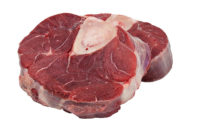The incentive for protein producers to expand their cooking operations has perhaps never been greater.
Not only are cooking technologies more efficient, but market interest in ready-to-eat and heat-and-eat meat and poultry is growing.
The share of shoppers who never prepare ready-to-eat options fell from 32 percent in 2010 to 18 percent in 2016, while those who never prepare heat-and-eat selections went from 40 percent to 21 in that span, according to the 2016 Power of Meat report .
Shoppers who prepare ready-to-eat meat and poultry at least once a week rose from 33 percent in 2010 to 47 percent in 2016, while those who prepare heat-and-eat items grew from 29 percent to 52 percent.
In addition, 15 percent and 19 percent of shoppers, respectively, prepare ready-to-eat and heat-and-eat meat and poultry at least three times a week, up from 10 percent for each segment in 2010.
Another enticement for processors to cook more meat and poultry is its complimentary relationship to raw proteins. Precooked products typically appeal to the large base of shoppers who are pressed for time or have limited cooking knowledge, and are important vehicles for enabling retailers to capture meals that may have gone to restaurants, the report notes.
The 2016 Power of Meat includes data from a November 2015 national online survey of 1,360 non-vegetarian or vegan adults who mirror the U.S. population. It is published by the Alexandria, Va.-based Food Marketing Institute and the Washington, D.C.-based North American Meat Institute.
“There is clearly a lot of demand for heat-and-eat and ready-to-eat items,” says Keith Belk, a professor in the Department of Animal Sciences at Colorado State University in Fort Collins. “Consumers feel good about the safety of the products and convenience as a demand driver is not going away.”
Outward bound
Many meat and poultry processors, meanwhile, are finding it judicious to use co-packers to cook their proteins because of inadequate plant capacity and resources, he notes.
Plants, for instance, often lack research and development centers — sites where operators can create and produce items without the risk of contaminating other lines of proteins by introducing new allergens and other elements to their facilities, Belk says.
“Processors need dedicated locations for designing the products,” he says. “That can be a big challenge for companies as it takes a huge capital investment to produce ready-to-eat and heat-and-serve items, and there must be Listeria and allergen controls. Plants that develop cooked products often have packaging areas that resemble hospital surgical suites.”
It is crucial for proteins to be safe from contamination after coming out of an oven or other cooking system, Belk notes, adding that it typically costs “many millions of dollars” to construct aseptic environments.
Components in such settings include floors, drainage systems, walls and ceilings that are easy to clean and do not have crevices and other areas that can harbor pathogens, he adds.
In addition to bacteria controls, a sound cooking operation also includes efficient equipment. Yet, advances in technologies are making machinery less of a burden for operators.
“Plant technology continues to improve for all proteins and there is more versatility in what companies can produce,” says John Reicks, chairman of the Washington, D.C.-based National Turkey Federation and vice president of internal operations for Springdale, Ark.-based Tyson Foods Inc. “There also are better process controls to enable better yields and reduce production costs.”
It often is the merchandising, rather than the cooking processes, that hampers market acceptance of newer ready-to-eat and heat-and-eat items, he says.
A major concern for processors and retailers is getting more consumers to sample unfamiliar precooked items, Reicks says.
“The technology is not a roadblock,” he says. “The issue in the turkey sector is that many consumers still think of turkey as just a Thanksgiving meal or as sliced meats.”
Cooked turkey options include jerky, bacon, sausage and burgers. It is important, meanwhile, for protein processors to keep developing new varieties of cooked items, he adds.
“The same old things won’t always catch the shoppers’ eyes,” Reicks says. “The quality also needs to be there or the product will die on the shelf.”
Different strokes
Another dynamic that can limit demand for some proteins are the disparate requirements of consumers over the way they want their meat prepared.
Unlike foodservice operations, in which consumers can dictate how chefs should cook their selections — such as rare, medium or well done — retail buyers of cooked meats have fewer options, says Shenoa French, director of innovation and product solutions for the Centennial, Colo.-based National Cattlemen’s Beef Association (NCBA).
The beef sector also has the additional onus of merchandising cooked products that often cost more than other proteins, she says. Prominent items include meatloaf and meatballs.
“There is a price difference from chicken to beef,” French says. “Some beef processors are less willing to spend a lot of time on cooked meats because the raw material is more expensive and that can result in high shrink dollars.”
Nevertheless, French predicts there will be growth in demand of cooked beef over the next few years as many consumers still will crave a wider variety of quick and convenient meal options.
A dilemma for the processors and retailers is pinpointing the new products that will likely catch on with shoppers.
“Consumers sometimes don’t know what they will like until it is available,” French says. “But there also is a risk to introduce new items and then work to get consumers to try the products.”
More of the newer selections will likely have cleaner labels with fewer ingredients to better appeal to health-conscious shoppers, she adds.
Follow the leader
Retailers also will be carrying additional selections of cooked meats that mimic items that are popular at foodservice locations, says Patrick Fleming, director of market intelligence and innovation for the Des Moines, Iowa-based National Pork Board (NPB).
Such options that already are prevalent in groceries include pulled pork and fully cooked ribs, he says.
“Once the processing infrastructure is in place at meat plants to prepare cooked products for foodservice, it is easy to also produce the items for retailers,” Fleming says.
A major NPB initiative is determining how to best promote the benefits of fully cooked ham to consumers, and the ways to sustain interest in the item after Easter. The organization is conducting qualitative and quantitative research to understand why usage drops off in the summer.
“Precooked is convenient and we haven’t fully gotten the message across to consumers that ham is fully cooked and ready to eat, and that most items are sliced and serve all dayparts,” Fleming says. “It may be more of a marketing problem and not a product problem.”
Another requirement for increasing sales of cooked pork items is redirecting some of the spotlight from the cooked chicken, beef and turkey sectors.
“Some of the other cooked proteins have been in the market longer and are more established than pork, so we have to make up for lost time,” Fleming states. “It is important to create unique profiles so a product doesn’t become a ‘me-too’ item.”
Future cooked pork products likely will include more ethnic flavors from around the globe along with the traditional regional flavors, he says.
“Getting new items into consumers’ hands and mouths always is a challenge,” Fleming says. “Shoppers want new and different products that they can try at home, but there are many new selections coming out. Yet any step that producers can take out of the food preparation process is better for consumers.”
Processors in all meat and poultry segments will likely benefit by keeping their focus on shoppers’ interest in convenience.
Precooked and partially cooked chicken products, for instance, continue to take up more space in both the fresh and frozen sections of retail meat departments, and the items also are becoming more popular with home delivery services, says Tom Super, vice president of the Washington, D.C.-based National Chicken Council.
Major processors, he says, see a move toward more precooked foods as “a wise way to build a more successful portfolio of go-to market product offerings. The bottom line is not so much about the cook getting out of the kitchen, but rather it is more about where the heavy-lifting part of cooking will get done.”
Roasted and rotisserie cooking in plants will be increasingly prominent, he says, while the large sector of health-conscious shoppers will lead operators to fry fewer proteins. The most prominent cooked chicken selections include nuggets, strips, tenders and patties.
In addition, upscale offerings, such as refrigerated chicken breast portions and possibly boneless/skinless thigh portions in additional flavors will likely become prevalent, Super says.
“If the economy can continue to become more buoyant, the rise in consumer incomes will allow more dollars to flow to prepared chicken and competing foods,” he says. NP








Report Abusive Comment